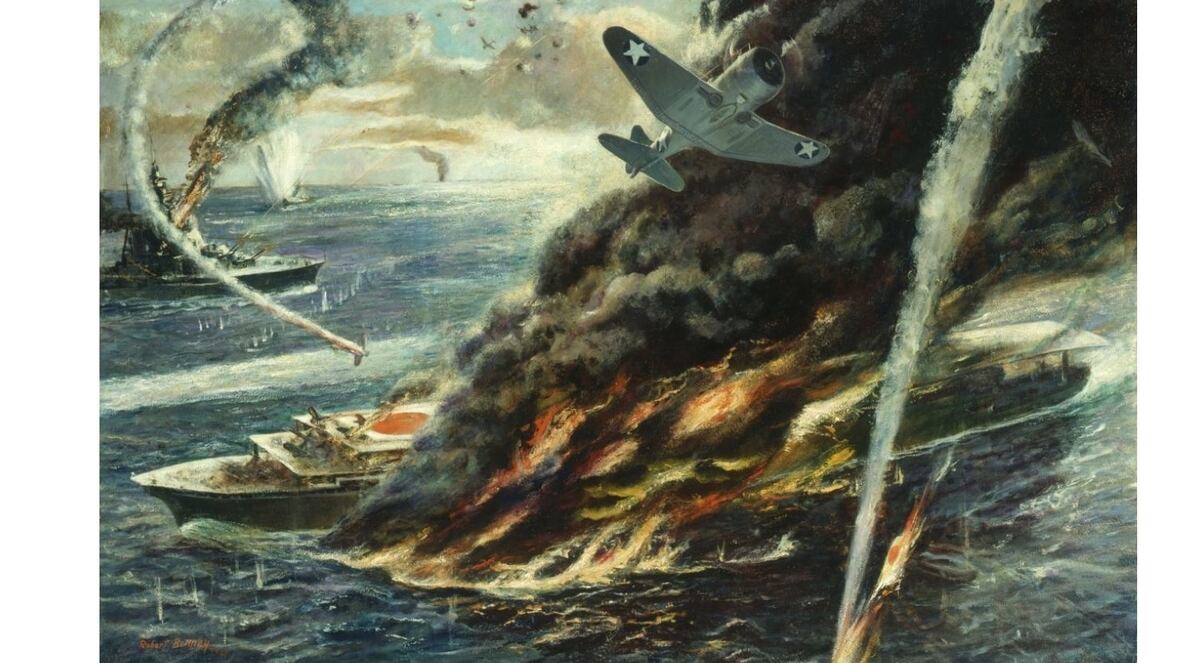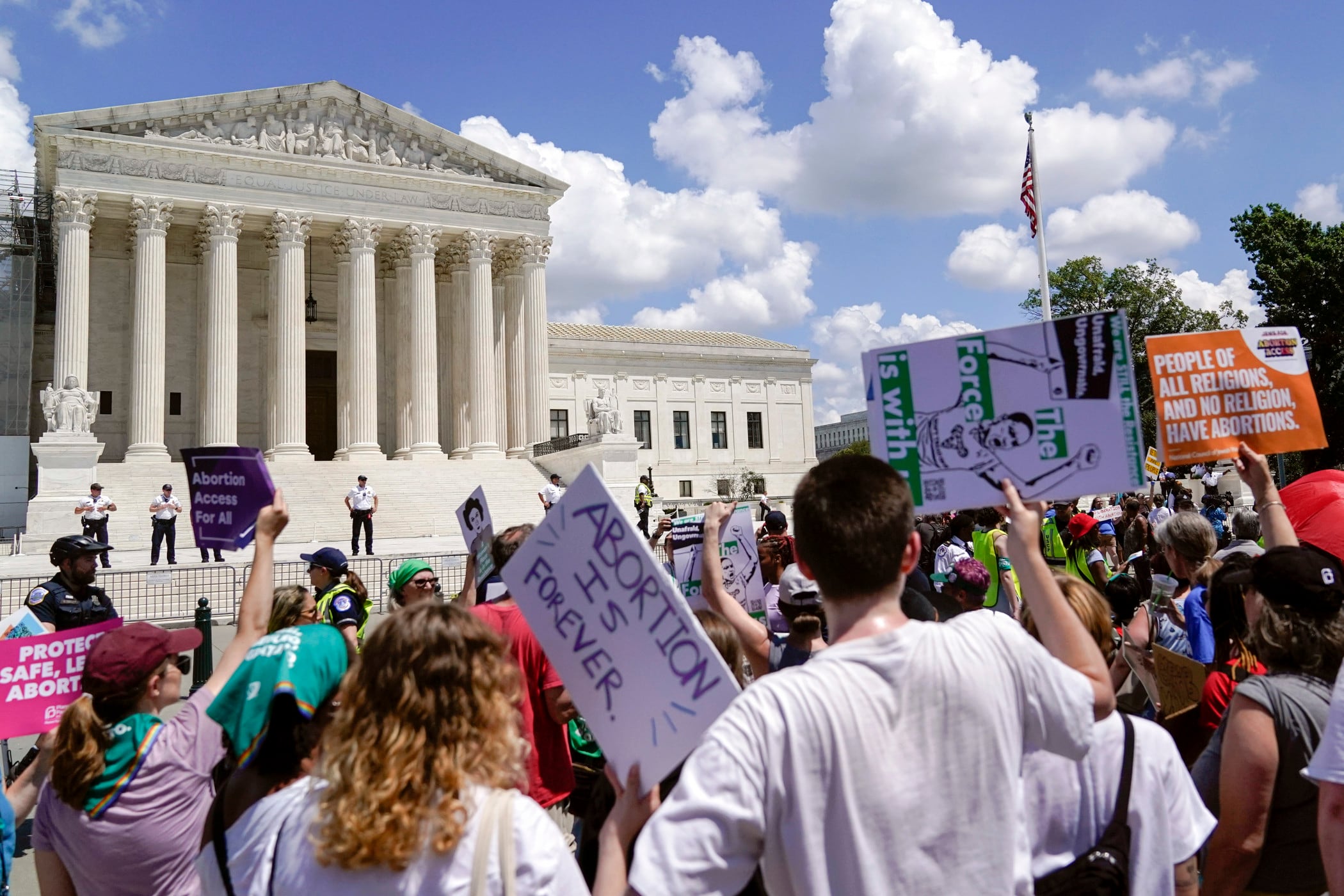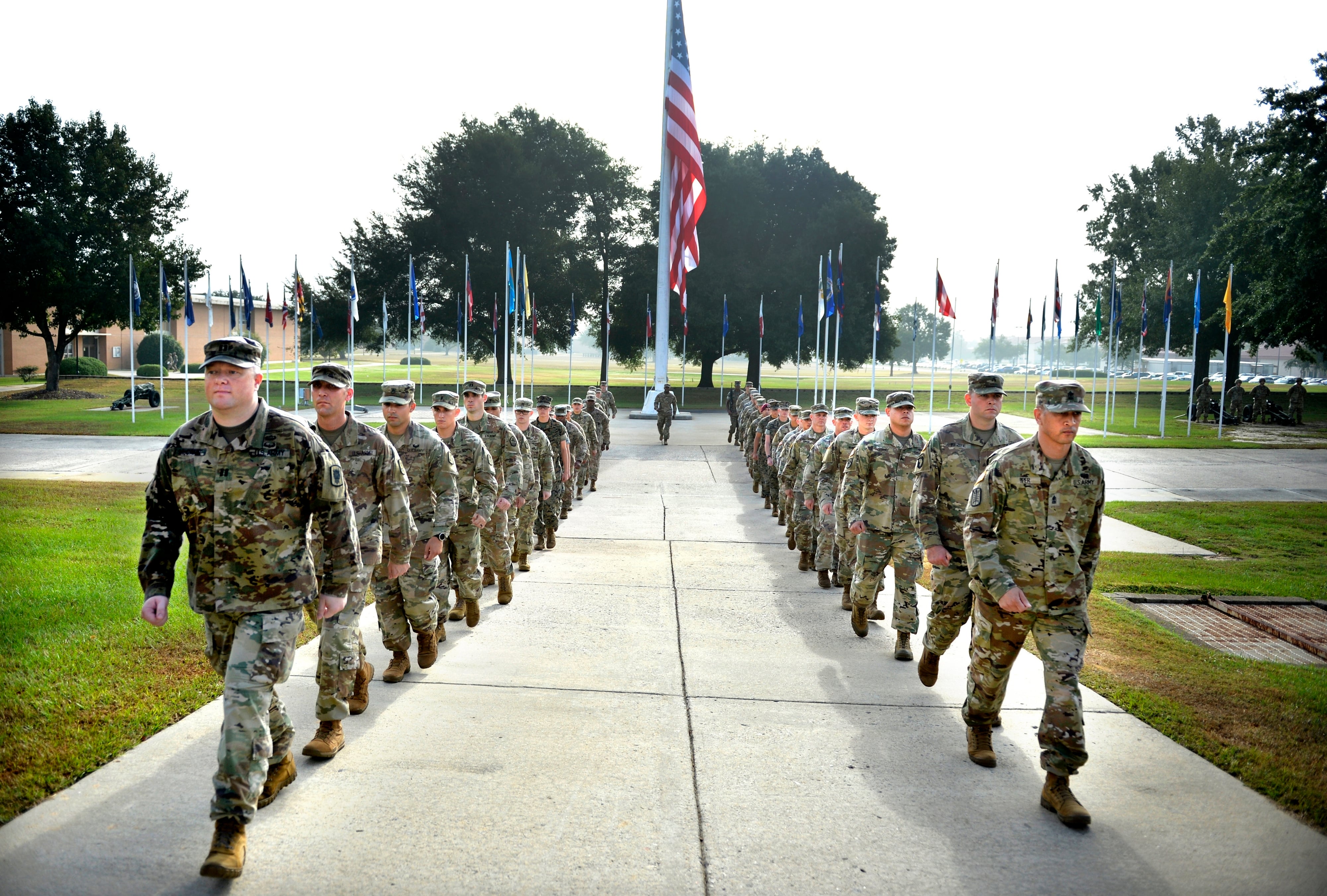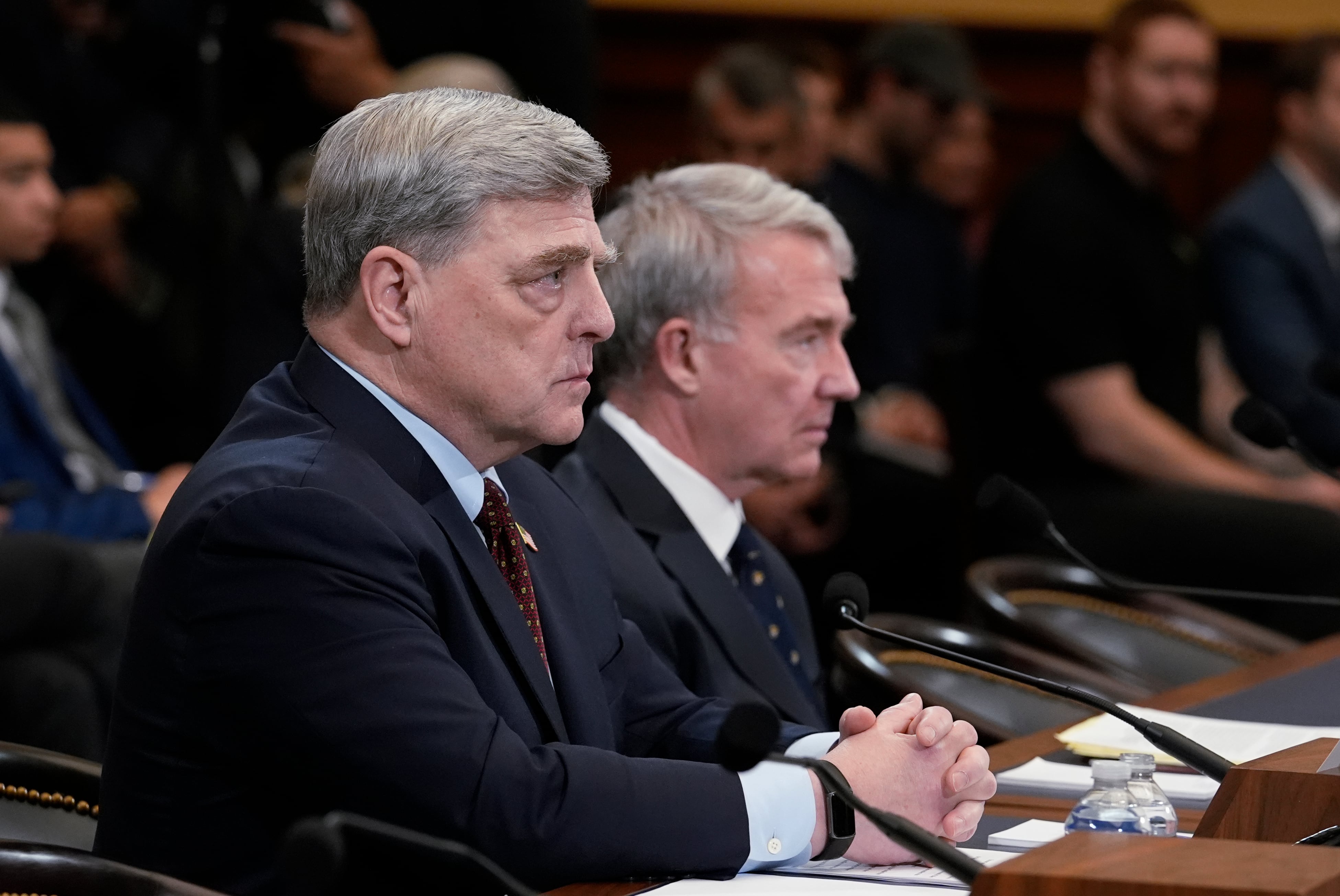In the weeks following the raid on Pearl Harbor, the armed forces of Japan rolled across the vast Pacific with the irresistible force of a tidal wave.
In what seemed to be hardly more than the blink of an eye, Japan had amassed one of the largest empires in history. From the lush, resource-rich Dutch East Indies and most of coastal China southward to the fetid, malarial swamps of New Guinea and the Solomons, nothing withstood the Japanese onslaught.
Even the mighty British fortress of Singapore at the tip of the Malay Peninsula proved little more than a minor bump in the road of conquest as the emperor’s soldiers advanced riding bicycles through the “impenetrable” jungle of the peninsula.
Whatever slim chance the Allies may have had to stop the enemy advance at its outset evaporated when much of the American aerial strength in the Philippines was caught on the ground and destroyed by enemy planes operating from bases on Formosa. These raids struck some five hours after the attack on Pearl Harbor, and even today, more than six decades after the event, there is no adequate explanation for the catastrophe that took place on the American airfields on Luzon.
Two days later, Japanese aircraft sank the Royal Navy’s newest battleship, Prince of Wales, and the battle cruiser Repulse off the coast of Malaya.
American naval installations in the Philippines, particularly those at Cavite on Manila Bay, were wrecked by a series of air raids. Bereft of support facilities and stripped of air cover, Adm. Thomas C. Hart ordered the ragtag collection of American warships that composed his command, the Asiatic Fleet, out of the Philippines.
They were sent southwestward to Java to join the naval forces of Britain, the Netherlands and Australia in the newly formed American, British, Dutch and Australian (ABDA) command in defense of the Dutch East Indies.
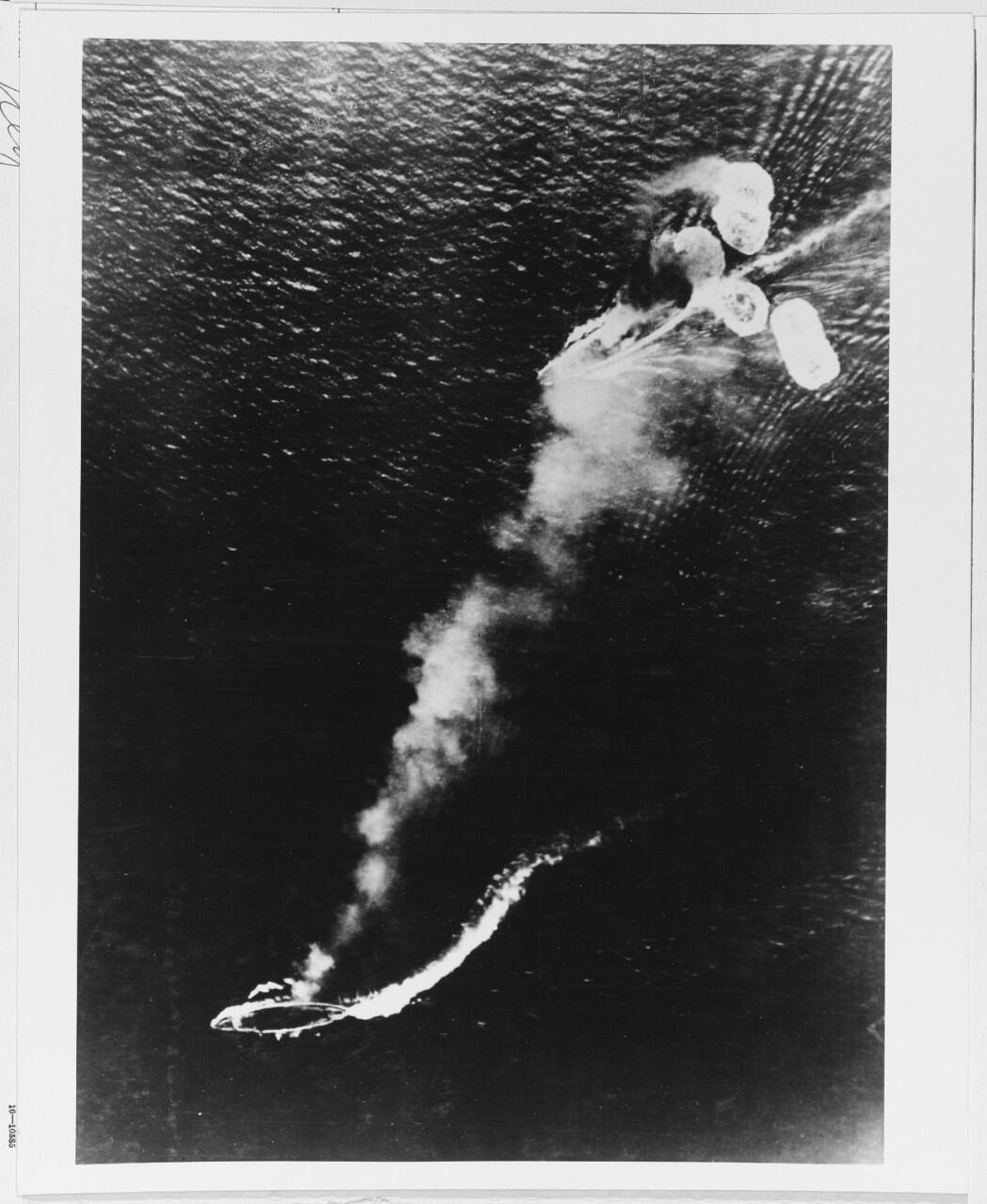
Prior to the war, the primary interaction among the ships of the various navies making up ABDA had been social calls when vessels of more than one nation were in port at the same time. Little or no planning for combined operations in the event of war had taken place, and when the conflict that most had expected for some months finally erupted, items as basic as a signal book common to the four fleets did not exist.
The heaviest units of the ABDA striking force were the American cruiser Houston and the British cruiser Exeter. In addition to the brace of heavy cruisers, the remainder of the force was composed of fewer than a dozen light cruisers and a handful of destroyers, most of which were of World War I vintage.
The only truly modern vessel in the command was the U.S. Navy’s light cruiser Boise.
Arrayed against this pitifully small force was the full power of the Imperial Japanese Navy. Heavily outnumbered, with little hope of reinforcement and fatally handicapped from the outset by the destruction of their air forces, many among the members of ABDA’s staff realized that there was little they could do to stop the Japanese.
Instead, they would be expected to give their lives to delay the enemy and hopefully inflict damage that would require some length of time to make good.
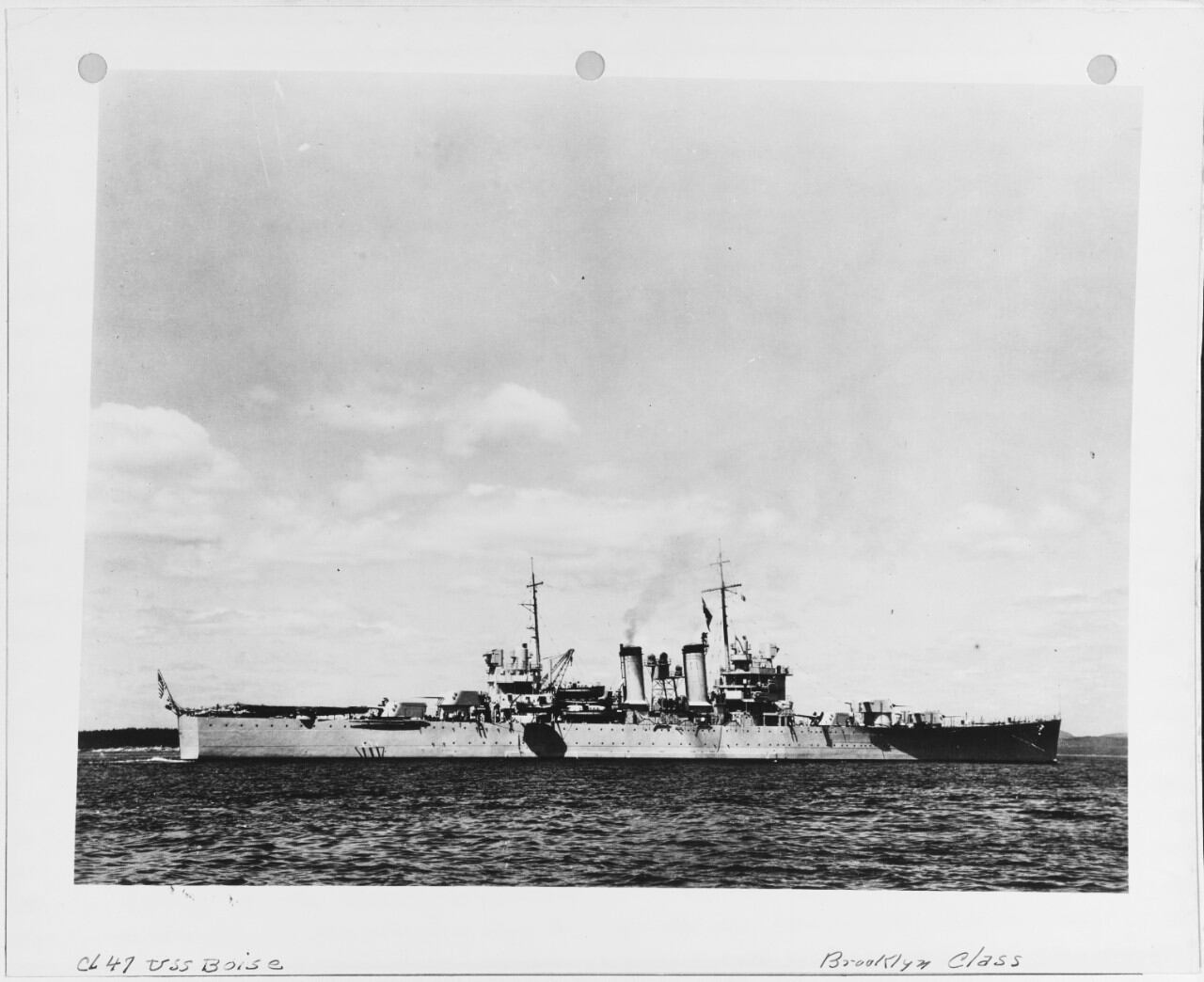
Foremost among the reasons the Japanese decided to risk all by initiating war with the Allies was the realization that the resource-poor Home Islands could never sustain the dream of empire that burned in the hearts and minds of many in the Japanese military.
Japan had to import virtually everything required to sustain a modern society, especially oil. If they were unable to gain control of the source of the strategic raw materials that they needed to continue their war of conquest in China, it would be far too easy for a powerful potential enemy such as the United States or Great Britain to halt the flow of oil — the lifeblood of the Japanese war machine.
When the United States, itself long an exporter of oil to Japan, placed an embargo on such shipments in the wake of its occupation of French Indochina, the Japanese estimated that less than a year’s supply of petroleum existed in the country.
As a result, the decision was made to go to war.
It is, therefore, ironic that the American forces at Pearl Harbor and in the Philippines, which bore the brunt of the initial Japanese strikes, were not the main objective. They were attacked to remove the primary threat to the eastward flank of the drive to the Dutch East Indies.
As the Allies reeled under the impacts of the hydra-like Japanese attacks from Pearl to the Philippines, Hong Kong and Malaya, numerous reports of enemy invasion convoys, some real and some not, flooded the various Allied headquarters.
To the harried crews of the Allied patrol aircraft that kept watch for the next Japanese thrust, anything larger than a native sampan was likely to be reported as a light cruiser; more than two vessels in company, regardless of their size, became an invasion force.
This confusion becomes easily understandable when one considers the psychological impact of the victorious Japanese attacks, and the speed at which they were executed. With the area under their control rapidly falling into enemy hands, Allied aircrews must have wondered if they would even have an airstrip to land on when they returned from their lengthy and extremely hazardous reconnaissance missions.
Despite those handicaps, the airmen of all the Allied nations scoured the seas in search of the enemy, and on Jan. 19, 1942, a prowling American Consolidated PBY Catalina sighted a Japanese invasion force steaming southward into the Makassar Strait east of Borneo.
Its discovery would set in motion the events that led to the U.S. Navy’s first surface engagement since the Spanish-American War.
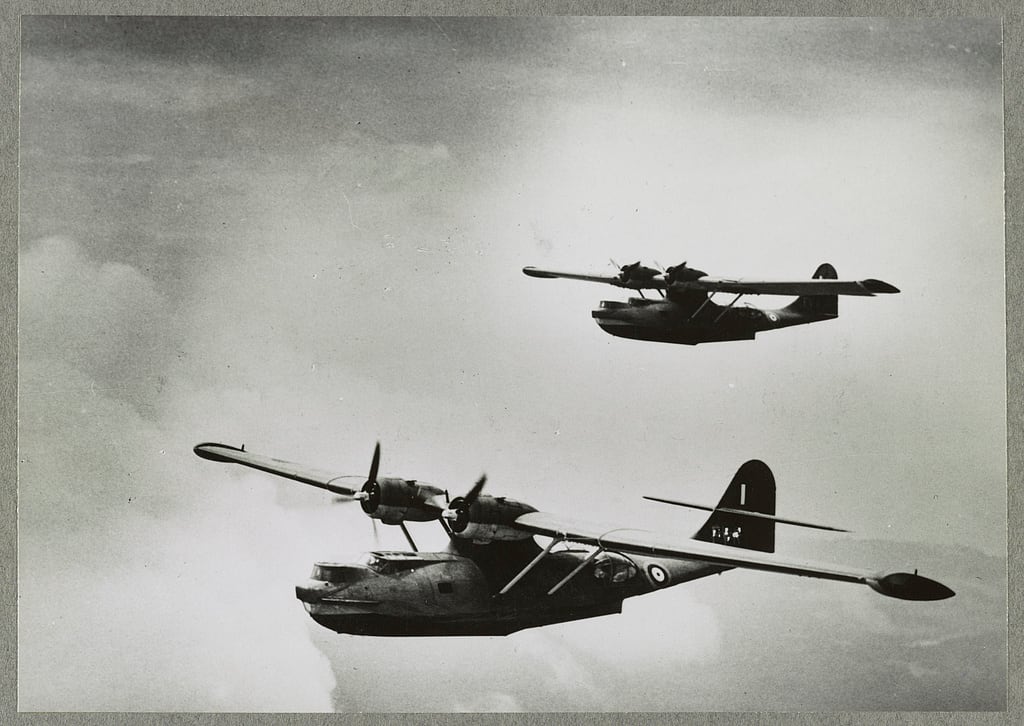
This enemy force, commanded by Rear Adm. Shoji Nishimura, consisted of 16 transports escorted by his flagship light cruiser Naka and a dozen destroyers.
It was bound for the vital oil port of Balikpapan on the eastern shore of Borneo, one of the largest islands of the East Indies that seemed to be floating on a vast sea of oil of unusual purity. Indeed, the output of many of the island’s wells was of sufficient quality that it could be pumped directly into a vessel’s oil bunkers, bypassing the refining process altogether.
The island and its vast oil reserves, not to mention the large refinery complexes that dotted the shore, was perhaps the richest prize in the Indies and an early target of the Japanese.
Fighting hard to defend their empire, the Dutch had resisted this enemy advance on Borneo with whatever they had.
On Jan. 23, Dutch Martin B-10 bombers managed to bomb Tatsukami Maru and Nana Maru, two transports of the approaching force. The burning Nana Maru was abandoned and sunk.
Determined as the Japanese were to seize their prize, however, the loss of just one transport was hardly enough to derail the assault. Japanese troops landed that same day and quickly moved inland to seize their objectives.
Allied command arrangements assigned the defense of the eastern islands of the Malay Barrier, which included Balikpapan, to the Americans. Therefore, an American surface strike force was ordered to prepare to attack the Japanese off the port.
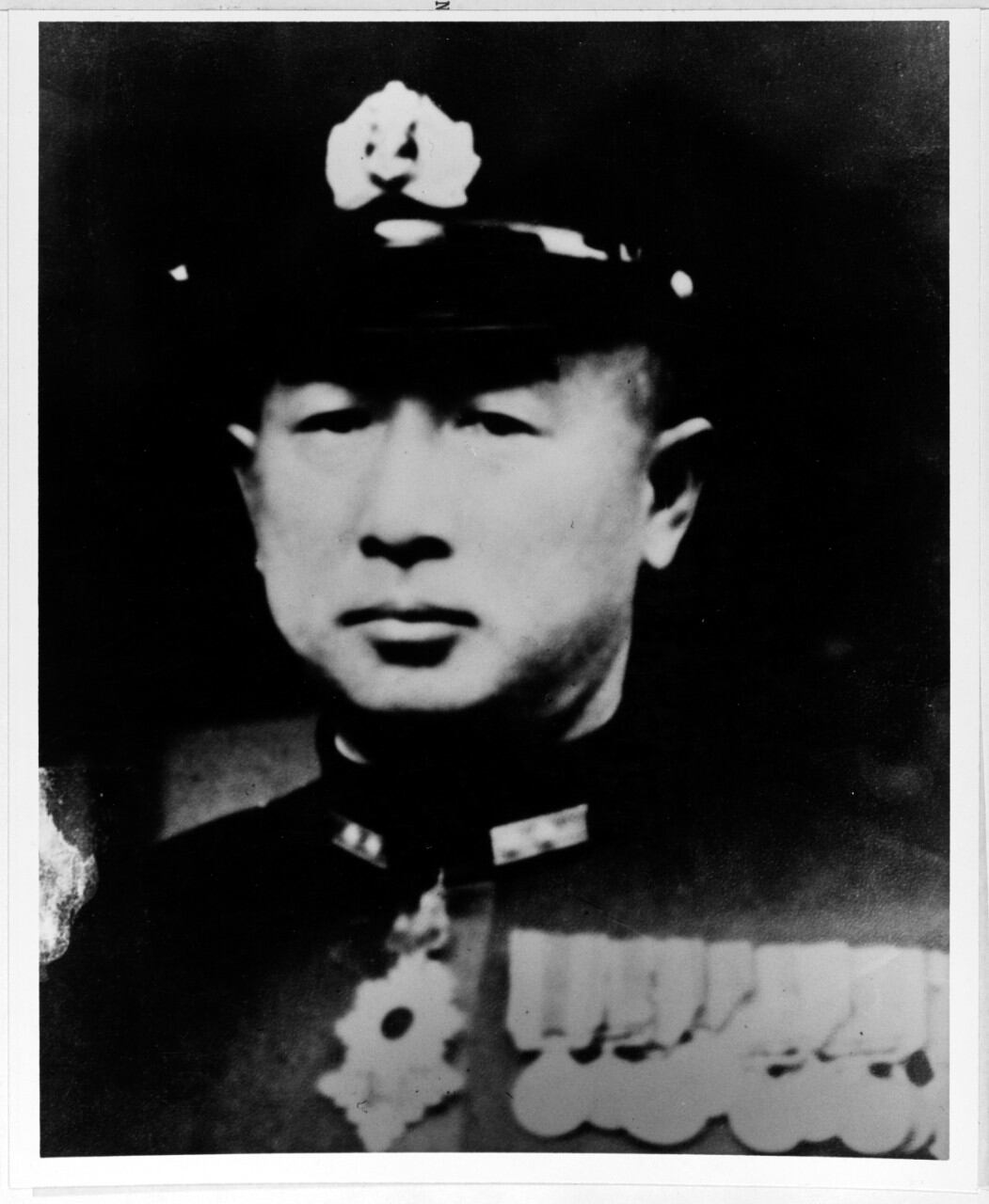
Despite the urgency of the situation, and the opportunity to strike a blow, battle-ready ships were in short supply. American warships were spread from one end of their operating area to the other, and the Asiatic Fleet entered the war a fleet in name only.
The strike force that Hart was eventually able to scratch together was made up of a pair of light cruisers and all the destroyers that were available — a total of four.
The destroyers were to initiate the action with night gunnery and torpedo attack. The cruisers were to follow with their own gunfire. It was hoped that with a little bit of luck, something definitely in short supply since Dec.7, the operation would be able to deal some heavy blows to the Borneo invasion force and if not check its landings, at least slow down the pace of the advance.
The strike force, commanded by Rear Adm. William A. Glassford, included Boise, the most modern ship in the Asiatic Fleet.
It was an example of the Brooklyn class that had been commissioned in 1939. It mounted 15 6-inch/47-caliber guns in five turrets that carried the latest fire control gear to direct the fire of the ship’s main battery.
The guns’ high rate of fire was ideal for the close range action that was anticipated. The ship could literally smother a target with fire. The second cruiser, Marblehead, had been commissioned in 1924 and was built to a World War I–era design.
It was, on paper at least, heavily armed with 12 6-inch guns. However, two-thirds of its main battery was mounted in stacked casemates at each corner of its superstructure. The antiquated arrangement of its battery and fire control system was little modified from its original form and made for a far less effective ship than Boise.
Those limitations notwithstanding, Marblehead was fast, nimble and, above all, available.
The destroyers of DesRon (Destroyer Squadron) 29 were of another era.
(Navy Times editor’s note: During World War II, the Navy shortened that to DesRon. We’ve kept the WWII conventions throughout this article.)
All were of the Clemson class of so-called “flushdeckers” originally designed to quickly provide the United States with adequate numbers of destroyers for World War I service.
By the time those ships joined the fleet, the “war to end all wars” had ended. So many of these hastily built ships had been completed, however, that they remained in service longer than was wise, delaying the development and construction of more modern vessels.
The profile of the antiques was unmistakable, with their flush decks and four stacks. Although obsolete in many respects, they were well armed, carrying a dozen torpedo tubes, four 4-inch guns in their main batteries and a single 3-inch anti-aircraft gun aft.
When word of the Japanese force bearing down on Borneo was received, the destroyers were ordered to prepare for sea and join the two cruisers in the strike against the invasion force.
Most of the squadron’s destroyers, however, were unavailable. Only John D. Ford, Pope, Parrott and Paul Jones from Cmdr. Paul H. Talbot’s Destroyer Division 59 were ready to sail.
Despite their small numbers, the destroyers quickly completed refueling, formed in column astern of the leading cruisers and steamed out of Koepang Bay, Timor, to do battle.

The odds were stacked against this small force from the outset. The escort for the Japanese invasion convoy was superior both in size and number. In addition to the escort, several other enemy naval forces were also in the area. Fortune would have to smile on the Americans if their plan had any hope of success.
Accurate charts of the area were in short supply, and as the column of U.S. warships transited the Sape Strait to enter the waters south of Borneo, Boise ran afoul of one of the many hazards of the sea, striking an uncharted rock pinnacle and suffering considerable damage. Its watertight integrity severely impaired, the cruiser was forced to return to port for repairs.
At almost the same time, Marblehead suffered a major engineering casualty when a turbine failed, which reduced the ship’s speed to 15 knots, rendering it impossible for the cruiser to accompany the destroyers into battle.
On board the four destroyers of DesDiv 59, more than a few stomachs must have churned at the prospect of a surface engagement without the numerous heavier guns of the destroyers in support. Nevertheless, the need to strike the enemy was great, and Glassford decided to carry on with the attack.
Marblehead would continue at its best speed to a point south of Balikpapan where it would be in a position to cover the withdrawal of the destroyers if any of them survived their attack.
During the afternoon of Jan. 23, the four destroyers continued northward up the Makassar Strait toward the enemy. Bucking the swells that marched across the waters of the strait, the ships’ bows rose high at the crest, only to be buried in the sea as they slid down the backside.
Hoping to confuse any enemy search aircraft in the area, Talbot ordered a change of course to the northeast toward the island of Celebes. His ships held this course until after sunset, when they made a turn north that would take them into harm’s way.
As the ships settled on this new course, Talbot’s voice came over the short-range tactical radio — known as the TBS, talk between ships — “Torpedo attack; hold gunfire until ‘fish’ are gone; use initiative and prosecute your strike to the utmost.”
On a northwestward course diagonally across from the strait and headed toward the enemy force lying off Balikpapan, speed was stepped up to 27 knots as the four old tin cans raced through the tropical darkness.
In column following the flagship John D. Ford, commanded by Lt. Cmdr. J.E. Cooper, came Pope, under Lt. Cmdr. W.C. Blinn; Parrott, under the watchful eye of Lt. Cmdr. E.N. Parker; and in the rear, Paul Jones, commanded by Lt. Cmdr. J.J. Hourihan.
By this time, well into the midwatch, the seas had calmed and the four little ships rushed at the Japanese with bones in their teeth.
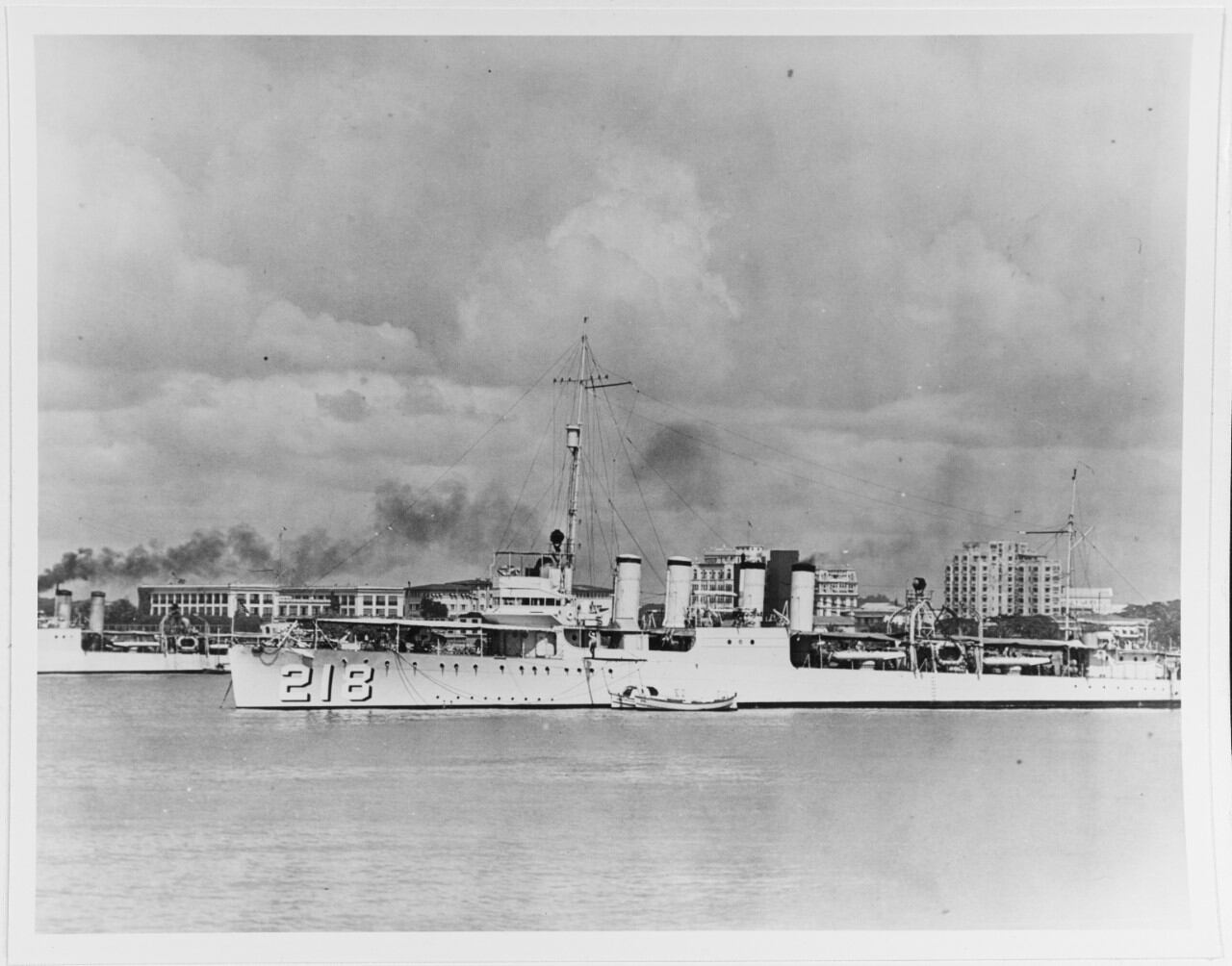
The glow of burning ships could now be seen on the horizon to the northeast. This light came from the flames on board the Japanese transports that had been hit during the Dutch air attack the previous afternoon.
The glow grew larger as the destroyers continued their approach. The gritty defenders of Borneo had set fire to many of the refineries in Balikpapan in order to deny them to the enemy, and these fires and the resulting clouds of roiling smoke, combined with the flames from the burning ships, intermittently bathed the area in a netherworld-like glow and silhouetted the Japanese ships against the backdrop of flame.
At other times, the drifting smoke completely hid the enemy from view. These conditions caused the seascape to the east to be even darker than it would have been if not for the fires, and the low banks of drifting smoke served to screen the Americans during the final phase of their approach.
As the destroyers drew close enough to make out their likely targets, they realized they had been presented with an almost undreamed of setup — anchored transports outlined by the burning refineries ashore and a smokescreen to hide them.
As the torpedomen began to take aim at their targets, a searchlight suddenly pierced the darkness off the starboard bow of John D. Ford.
It was a challenge from one of the quartets of Japanese destroyers crossing the American column from starboard to port.
Talbot ordered a course change in an effort to deceive the enemy; it apparently worked, as the Japanese ships disappeared into one of the banks of smoke.
A few minutes later, the Americans altered course to once again take their original heading toward the enemy.
As the four destroyers settled on their new route, they began to pick up targets. Parrott was the first to fire, launching a spread of three torpedoes at one of the anchored transports.
All three missed their intended target.
After a slight alteration in its course to port, the destroyer quickly set upon another transport and sent five torpedoes on their way.
Again, the torpedoes missed.
As Parrott was letting fly with its second salvo, Ford launched a single torpedo at another of the enemy ships, followed by Paul Jones at 0257 with a single shot at a target believed to be a large destroyer or cruiser, glimpsed briefly through the smoke.
In fact, the intended victim was a small minesweeper. There were now 10 American torpedoes in the water and not a single one had found its target.
The wakes of the 10 torpedoes crisscrossing the dark waters off Balikpapan were sufficient to alert the Japanese. Signal lights flashed in all directions, and random shots were fired at phantoms, none falling anywhere near Talbot’s ships.
The previously anchored transports quickly slipped their cables to escape from the danger. As confusion reigned among the Japanese, at 0300 Cmdr. Talbot led his ships about in a circle for another crack at the enemy.
As the destroyers came about, Parrott launched three more torpedoes.
This time the weapons found their mark, and Sumanoura Maru, apparently loaded with munitions, erupted in an earth-shaking blast, its broken remains quickly slipping beneath the waves.
As the American tin cans ran through the Japanese assault force, an enemy destroyer squadron raced through the area headed into the Makassar Strait. If these modern destroyers had stopped to fight Talbot, the results would have been grim.
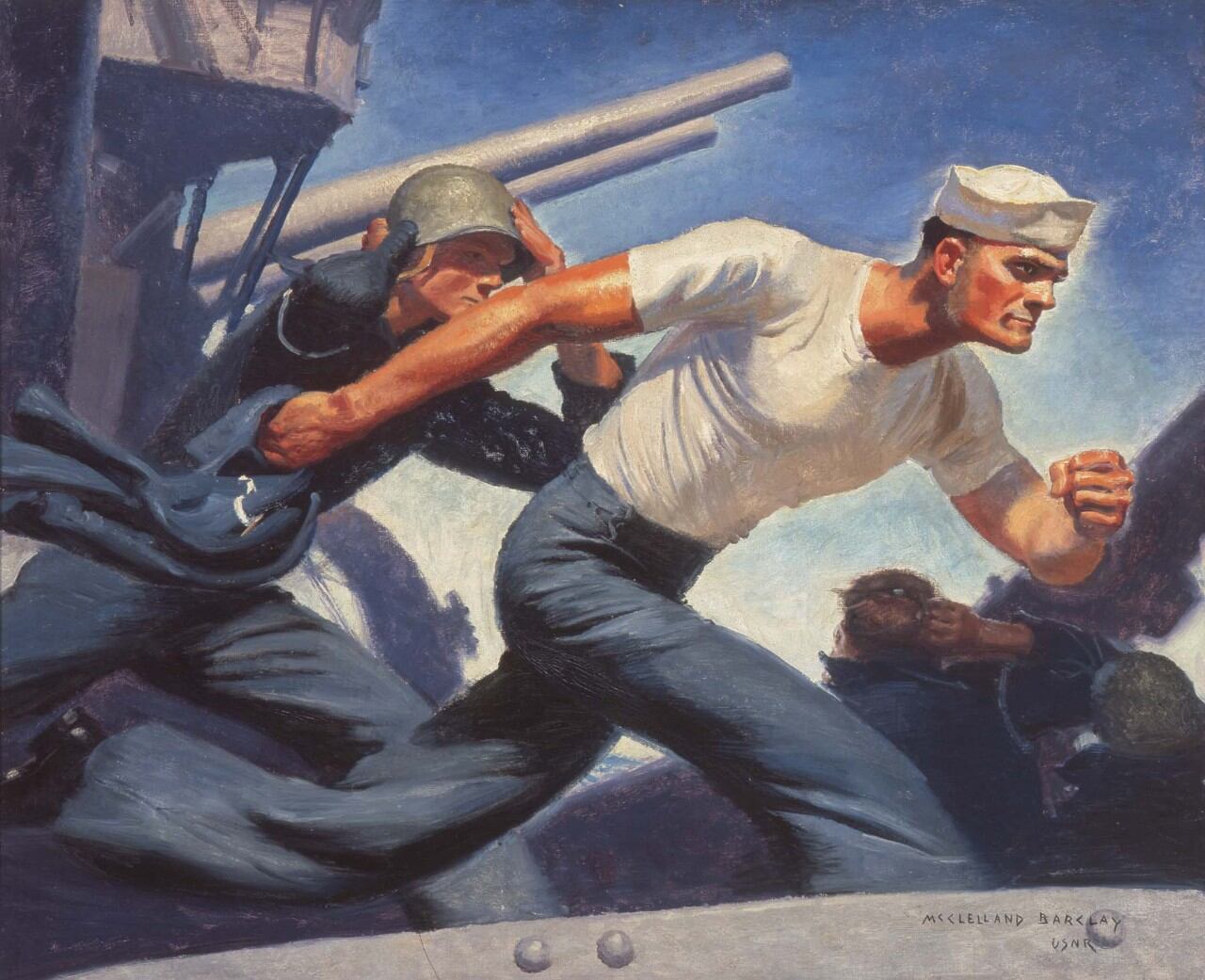
Shortly before the Americans arrived, however, the Dutch submarine K-XVIII had unsuccessfully fired four torpedoes at Naka, but subsequently succeeded in torpedoing and sinking Tsuraga Maru.
Consequently, Nishimura had ordered his destroyers to abandon the transports and move through the area in search of K-XVIII and other lurking submarines.
Thus, granted a reprieve, Talbot’s ships continued their work. At 0306 Pope loosened a spread of five torpedoes at a target silhouetted against the flames.
Again, however, all five missed.
Parrott fired its own salvo, which missed as well.
Paul Jones tried its luck moments later. This time, the result was more satisfactory, as the already damaged Tatsukami Maru, a transport of some 7,000 tons, went down.
At 0319 Pope and Parrott again launched torpedoes at what they thought was an enemy destroyer but was, in fact, the small patrol vessel PC-37.
Ford and Paul Jones now each fired a single torpedo at a large transport.
Just as the second torpedo splashed into the sea, the water at the stern of the target began to boil, the vessel’s screw thrashing the sea into froth as it hurriedly got up steam to escape its tormentors.
The torpedoes missed astern.
While this was taking place, Talbot ordered his ships to come about and head north through the anchorage yet again.
At 0325 Paul Jones fired a single torpedo at the ship it had missed minutes earlier, the 5,000-ton Kuretake Maru, which this time hit amidships and forced the mortally wounded transport to stop.
As they looped westward in their course change, Pope, Parrott and Paul Jones reported, “All torpedoes expended,” and Talbot ordered them to open fire independently with their 4-inch guns while Ford readied its final torpedo salvo for the next suitable target.
It fired one at a target at 0346 and its final pair at a group of three transports.
None of the torpedoes found their mark.
In a May 1943 article, Ford’s gunnery officer, Lt. William P. Mack, tried to explain what happened.
Now I knew the stage was mine. Many a time I had fired at target rafts, but this was the real thing. ‘Commence firing!’ rang in my earphones. I was ready, but how different this was from peacetime firings! I could still remember the sonorous arguments of the publications I had studied at the Naval Academy over the ... effectiveness of searchlights and star shells.
I didn’t use either, nor did we use any of the complicated fire-control apparatus installed. This was a draw shooting at its best. As targets loomed out of the dark at ranges of 500-1,500 yards, we trained on and let go a salvo or two, sights set at their lower limits, using the illumination furnished by burning ships.
Finally we sighted a transport far enough away to let us get in three salvoes before we had passed it. The projectile explosions were tremendous. Deck-plates and debris flew in all directions. When we last saw her she was on end and slipping slowly under….
A transport began firing at us. I turned my guns on her, but before we could silence her, a shell had hit us aft. Flames grew and spread around the area. Over the telephone I could hear a torpedoman describing the damage, ‘four men wounded, the after deckhouse wrecked, ammunition burning.’
Thirty seconds later the burning ammunition had been thrown over the side, the wounded men cared for and the gun crew was firing again.
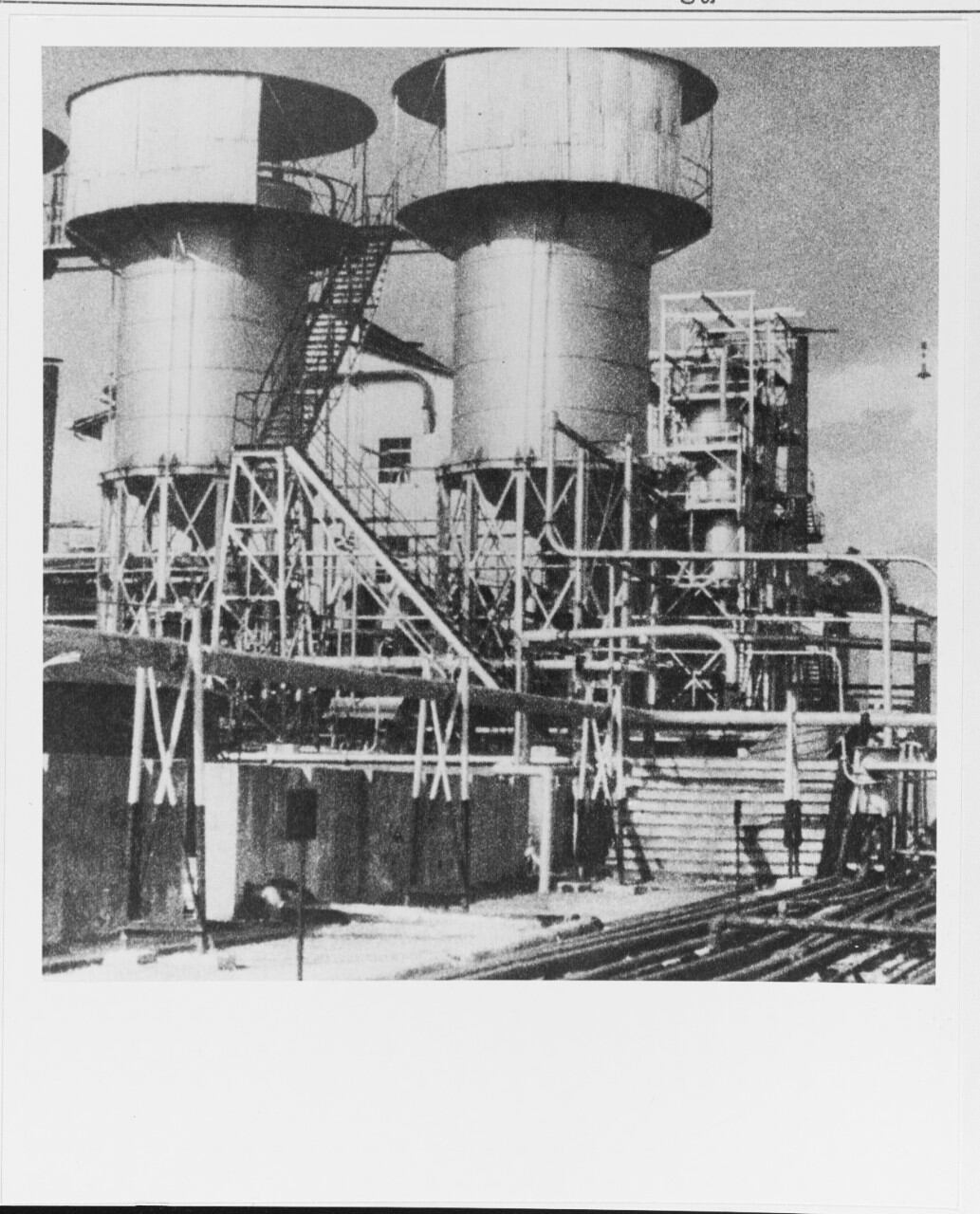
With his torpedoes expended, Ford damaged and significant enemy forces in the area, Talbot decided that his tiny force had pushed its luck far enough and ordered his ships to withdraw before the Japanese destroyer squadron returned from its submarine hunt.
On board the American destroyers, their force draft blowers’ whine increased in pitch as engineers belowdecks squeezed every last knot out of the old power plants. Later it was recorded that Ford reached almost 32 knots, faster than it had run since its sea trials two decades earlier.
As the destroyers withdrew, the eastern horizon began to brighten with the approach of a new day, while to the west the flames from burning enemy ships lighted the skies.
“For almost 30 minutes we ran south before dawn came,” Mack remembered. “All hands strained their eyes astern for signs of pursuit that we thought inevitable. We could see none. The only ships in sight were three familiar shapes on the port bow that we knew to be the Parrott, Paul Jones and Pope. Proudly they fell in astern of us, and sped south together.
"Down on the bridge, a flag hoist whipped out smartly; ‘Well done!’ it said.”
The flag hoist signaled the end of the Battle of Balikpapan.
Shortly after 0800, the destroyers of DesDiv 59 rendezvoused with Marblehead and the little force continued south at the cruiser’s best speed.
Their victory could not alter the ultimate fate of Balikpapan, which remained in Japanese hands until 1945, but at a cost of superficial damage to Ford, DesDiv59 had removed some 23,000 tons of shipping from the Japanese muster roll.
The enemy’s string of victories would continue until the battles of the Coral Sea in May and Midway in June, but Balikpapan represented the U.S. Navy’s first victory in World War II and demonstrated that following the Japanese attack at Pearl Harbor, the Navy was down but definitely not out.
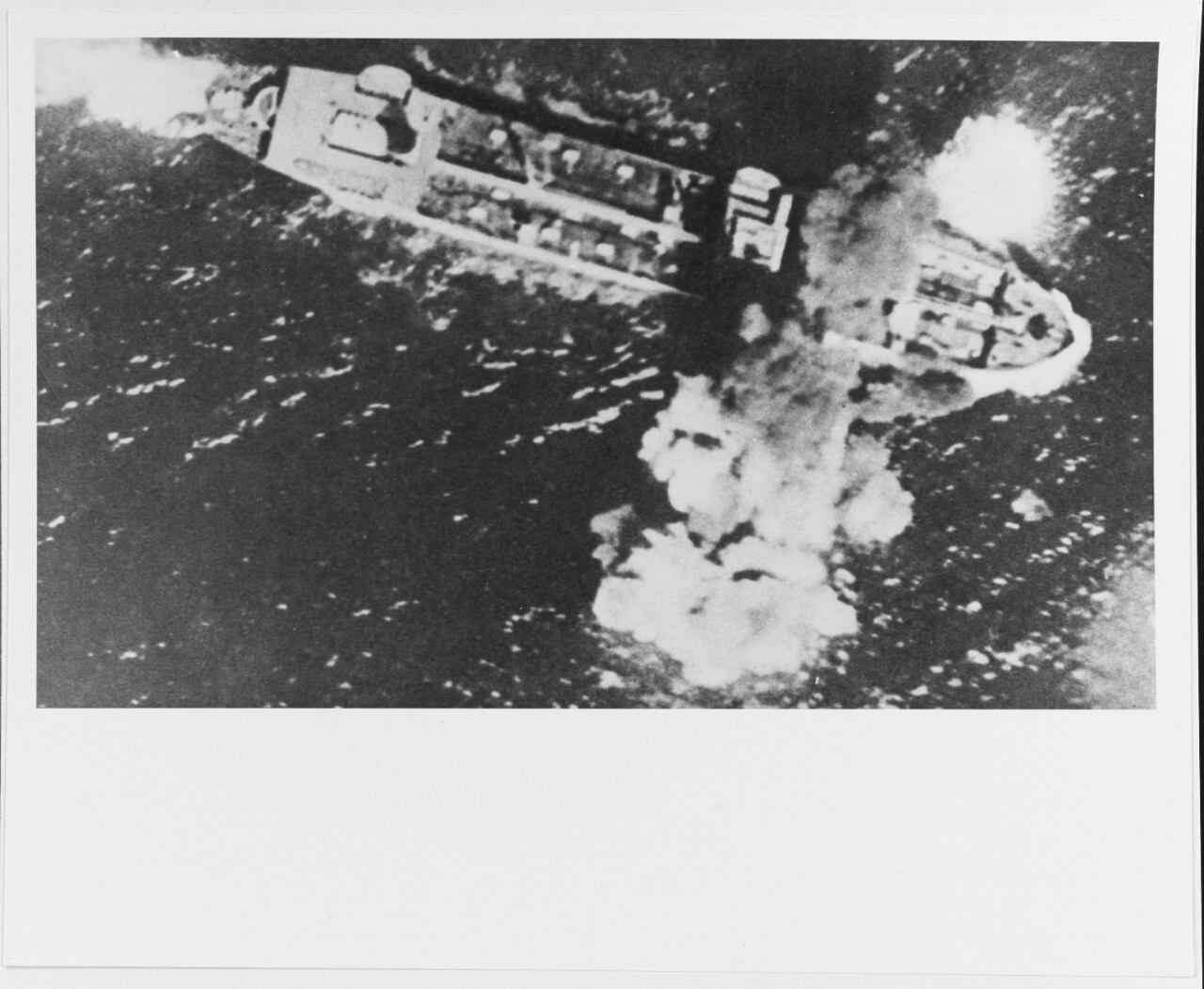
Michael Crowder writes frequently on naval matters for World War II magazine. For further reading, see History of United States Naval Operations in World War II: The Rising Sun in the Pacific 1931-April 1942, by Samuel Eliot Morison.
This article originally appeared in the February 2006 issue of World War II, a sister magazine of Navy Times. To subscribe, click here.
RELATED
